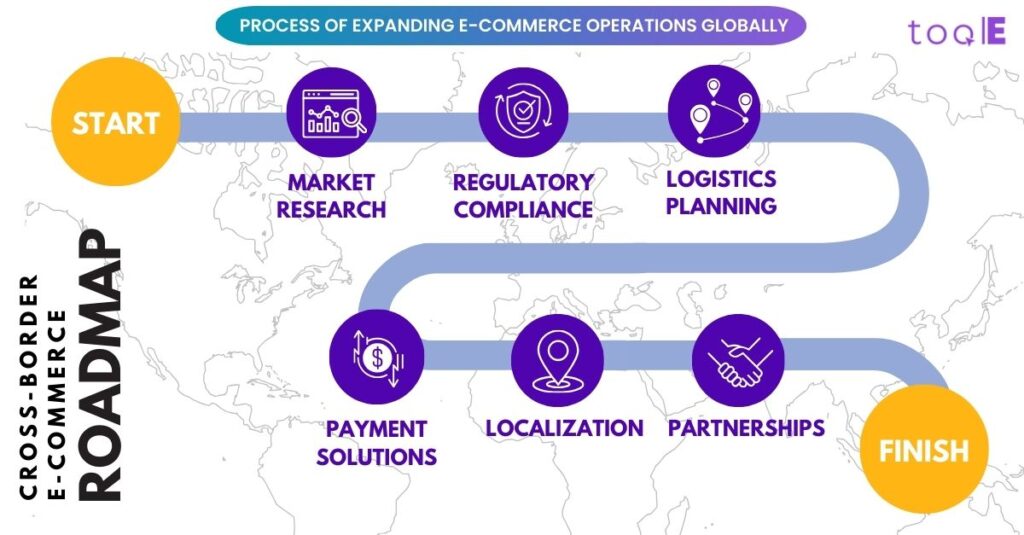Expanding e-commerce operations globally is an exhilarating endeavor that opens doors to new markets and revenue streams. However, the journey is fraught with complexities that require strategic planning and meticulous execution. This post delves into the multifaceted challenges of cross-border e-commerce, including regulatory hurdles, logistical intricacies, and currency exchange management, while offering practical strategies to overcome these obstacles.
1. Regulatory Compliance
Understanding Local Regulations
Each country has its own set of regulations governing e-commerce operations, including product standards, labeling requirements, import duties, and taxes. These regulations can vary significantly and are subject to change, making it imperative for businesses to stay informed and compliant.
Strategies to Navigate Regulatory Challenges:
– Continuous Research: Regularly update your knowledge on the regulatory landscape of each target market. Subscribe to industry newsletters, join international trade associations, and participate in forums and webinars.
– Local Expertise: Engage local legal experts and consultants who understand the nuances of local laws and can provide tailored advice. This approach helps in avoiding costly legal pitfalls and ensures smooth operations.
– Automated Compliance Tools: Utilize software solutions designed to track and manage compliance requirements. These tools can alert you to regulatory changes and help maintain accurate records.
Case Example:
A U.S.-based skincare brand entering the European market must comply with the EU’s stringent cosmetic regulations, which require detailed product labeling, ingredient lists, and safety assessments. By partnering with a European regulatory consultancy, the brand can ensure compliance and avoid legal issues.
2. Logistics Management
Overcoming Logistical Hurdles
Efficient logistics are crucial for delivering a seamless customer experience in cross-border e-commerce. This involves navigating international shipping regulations, customs procedures, and varying delivery timelines.
Strategies to Enhance Logistics:
– Reliable Logistics Partners: Partner with established international shipping and logistics providers who have a robust understanding of cross-border operations. Companies like DHL, FedEx, and UPS offer comprehensive solutions and support.
– Advanced Tracking Systems: Implement tracking systems that provide real-time updates on shipment status. This transparency helps build customer trust and allows for proactive issue resolution.
– Warehousing Solutions: Consider establishing warehouses in key markets to reduce shipping times and costs. Fulfillment centers close to your target customers can enhance delivery speed and efficiency.
Case Example:
An Australian fashion retailer expanding to North America can benefit from partnering with a 3PL provider that offers warehousing solutions in major U.S. cities. This setup enables faster delivery times and reduces shipping costs, improving customer satisfaction and loyalty.

3. Currency Exchange
Managing Currency Fluctuations
Handling multiple currencies is another critical aspect of cross-border e-commerce. Exchange rate fluctuations can impact pricing, profit margins, and overall financial planning.
Strategies for Effective Currency Management:
– Multi-Currency Pricing Tools: Use e-commerce platforms that support multi-currency pricing. Displaying prices in local currencies helps customers make informed purchasing decisions and enhances the shopping experience.
– Payment Gateways: Implement payment gateways that accept various currencies and offer competitive exchange rates. This flexibility reduces friction during the checkout process and minimizes cart abandonment.
– Hedging Strategies: To mitigate the impact of currency volatility, consider financial instruments such as forward contracts and options. These tools can lock in exchange rates and protect against adverse movements.
Case Example:
A UK-based electronics retailer expanding to Asia can leverage a payment gateway like PayPal or Stripe, which supports multiple currencies and offers favorable exchange rates. This approach simplifies transactions for customers and stabilizes the retailer’s revenue streams.
4. Localization and Market Adaptation
Tailoring Your Approach
Successful cross-border e-commerce requires more than just logistical and regulatory adjustments; it necessitates a deep understanding of local markets and cultural preferences.
Strategies for Effective Localization:
– Localized Content: Adapt your website, product descriptions, and marketing materials to reflect local languages and cultural nuances. This effort demonstrates respect for local customers and increases engagement.
– Customer Service: Provide multilingual customer support to address queries and resolve issues efficiently. Investing in local customer service teams can significantly enhance the customer experience.
– Market Research: Conduct thorough market research to understand consumer behavior, preferences, and purchasing patterns in each target market. Use this data to tailor your product offerings and marketing strategies.
Case Example:
A German home decor brand entering the Japanese market should adapt its website to include Japanese language options, culturally relevant imagery, and localized marketing campaigns. Additionally, offering customer service in Japanese can further build trust and loyalty among local consumers.
5. Building Strong Partnerships
Collaborating for Success
Forming strategic partnerships with local businesses, influencers, and industry leaders can significantly boost your cross-border e-commerce efforts.
Strategies for Building Partnerships:
– Local Distributors: Partner with local distributors who have established networks and market knowledge. These partnerships can expedite market entry and enhance brand visibility.
– Influencer Collaborations: Collaborate with local influencers to promote your products and build brand credibility. Influencers can effectively bridge the gap between your brand and the local audience.
– Joint Ventures: Consider joint ventures with local companies to share resources, expertise, and market insights. This approach can mitigate risks and amplify your growth potential.
Case Example:
A Canadian health supplement brand aiming to enter the South Korean market can partner with a local distributor specializing in health products. Additionally, collaborating with popular health influencers can drive awareness and build a loyal customer base.
6. Leveraging Technology
Harnessing Digital Tools
Embracing technology is essential for managing the complexities of cross-border e-commerce and staying competitive in the global marketplace.
Strategies to Leverage Technology:
– E-commerce Platforms: Use robust ecommerce platforms like Shopify Plus, Magento, or BigCommerce that support international sales and offer features like multi-currency support, localization, and seamless integrations.
– Analytics Tools: Implement analytics tools to track customer behavior, sales performance, and market trends. Insights from these tools can inform data-driven decisions and optimize your strategies.
– Automation: Automate repetitive tasks such as order processing, inventory management, and customer communications. Automation improves efficiency and allows you to focus on strategic growth initiatives.
Case Example:
A French beauty brand using Shopify Plus can leverage the platform’s multi-currency and localization features to create a tailored shopping experience for customers in different regions. Additionally, integrating with analytics tools like DataDash can provide valuable insights.
Conclusion
Expanding into cross-border e-commerce is a challenging yet rewarding journey that demands careful planning, strategic partnerships, and continuous adaptation. By understanding and addressing the complexities of regulatory compliance, logistics, currency exchange, localization, and technology, businesses can successfully navigate the global e-commerce landscape and unlock new growth opportunities.





